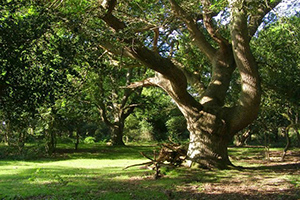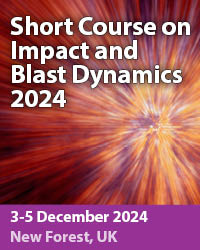Description
The WIT Short Course on Impact and Blast Dynamics is designed to equip professional engineers, researchers and post-graduate students with the knowledge, tools and methods to analyse and better understand problems associated with large dynamic loads produced by a variety of sources, typically structural impact and explosions. The main aims of the course are to introduce the fundamentals of impact and blast dynamics, concepts, principles and simplified methods of design and analysis. This course will also cover introductory techniques and design approaches for impact- and blast-resistant structures.
The course will cover dynamic material behaviour, the response of structures to impulsive loads, and their relevance of these in real-life applications. We will make extensive use of case-studies and practical design examples, applied to structural crashworthiness, armour and protection systems, explosion mitigation, and design for safety throughout the civil, mechanical, nuclear, transportation and space industries. Hands-on sessions will give participants an opportunity to solve real-life problems using the analysis methods and tools delivered in the course.
Programme
Sessions will be presented on the following topics:
- Day 1 (3rd Dec) – Impact Mechanics I:
-
- Morning: Welcome and introductions. Course planning, aims and objectives, tools and resources.
- Morning: Introduction to and relevance of impact mechanics (with applications and case studies).
- Afternoon: Introduction to the dynamic behaviour of materials.
- Afternoon: Impact loading on structures, dynamic crushing.
- Day 2 (4th Dec) – Impact Mechanics II:
-
- Morning: Impact threat, penetration and perforation mechanics.
- Morning: Design methods for energy absorption and crashworthiness.
- Afternoon: Tools and techniques for impact assessment and modelling.
- Afternoon: Impact applications, protection technology and case studies.
- Day 3 (5th Dec) – Blast Mechanics:
-
- Morning: Introduction to shock waves. Blast loading and scaling laws.
- Morning: Blast interaction with structures and structural response to blast loading.
- Afternoon: Blast and shock assessment techniques/tools, applications and case studies.
- Afternoon: Blast-resistant design methods.
Presenter

Professor Filipe Teixeira-Dias FIMechE is a Mechanical Engineer, academic and author of over 250 publications, including more than 70 in international peer-reviewed journals. He started his academic career in 1992 at his Alma Mater, the University of Coimbra (Portugal), moving to the University of Aveiro (Portugal) in 1997. In 2013 he moved to The University of Edinburgh where he holds the Personal Chair of Impulsive Dynamics. His research interests focus on understanding the behaviour of materials and structures under impulsive and dynamic loads, and improving their response through better energy absorption mechanisms at different scales. His research primarily combines the use of numerical, experimental and analytical/theoretical approaches and methods, with wide applications in impulsive/structural dynamics; materials for energy absorption; protection and armour systems; sports impact and human bio-dynamics; crashworthiness; terminal ballistics, blast and shock wave dynamics, and hypervelocity impact. He is a co-founder of the Light-Weight Armour for Defence & Security Group (LWAG) and was president of the LWAG from 2008 to 2012. He was the Director of Mechanical Engineering (School of Engineering, The University of Edinburgh) from 2021 to 2024 and is a member of the Institute for Infrastructure and Environment (IIE) and of the Centre for Science at Extreme Conditions (CSEC).
Location
 The New Forest is one of the UK's most popular tourist destinations and offers many attractions all year round, including picturesque forest villages as well as beautiful scenery. It is located in Southern England, spreading over 150 square miles of Hampshire. The New Forest was established as a royal hunting ground by King William I, and by the 14th century, the land was being used to produce timber for the shipbuilding industry on the south coast. Today, after nearly 1000 years, the forest is still Crown property and is administered by the Forestry Commission. Since the reign of King William I commoners have been given the right to graze their livestock, normally ponies, cattle and pigs, on Forest land where they wander freely. In the New Forest, the well-being of the animals and the special needs of the countryside are a priority. The Forest is unarguably recognised as one of the most unique and important wilderness areas in Western Europe and, because of this, it is now a National Park.
The New Forest is one of the UK's most popular tourist destinations and offers many attractions all year round, including picturesque forest villages as well as beautiful scenery. It is located in Southern England, spreading over 150 square miles of Hampshire. The New Forest was established as a royal hunting ground by King William I, and by the 14th century, the land was being used to produce timber for the shipbuilding industry on the south coast. Today, after nearly 1000 years, the forest is still Crown property and is administered by the Forestry Commission. Since the reign of King William I commoners have been given the right to graze their livestock, normally ponies, cattle and pigs, on Forest land where they wander freely. In the New Forest, the well-being of the animals and the special needs of the countryside are a priority. The Forest is unarguably recognised as one of the most unique and important wilderness areas in Western Europe and, because of this, it is now a National Park.
Venue and Accommodation
The course will take place at the Wessex Institute at Ashurst Lodge located in the New Forest, an outstanding National Park that borders the South Coast. Ashurst Lodge is an ideal venue for conferences, courses and seminars. The participants can benefit from an excellent standard of accommodation in various hotels or bed and breakfasts in the area. The surroundings are equally appealing to those who enjoy walking, horse riding, cycling, sailing and fine landscapes.
For more information on how to find Ashurst Lodge and to arrange accommodation during the courses please use the information provided on the Contact Us page.



 Wessex Institute
Wessex Institute